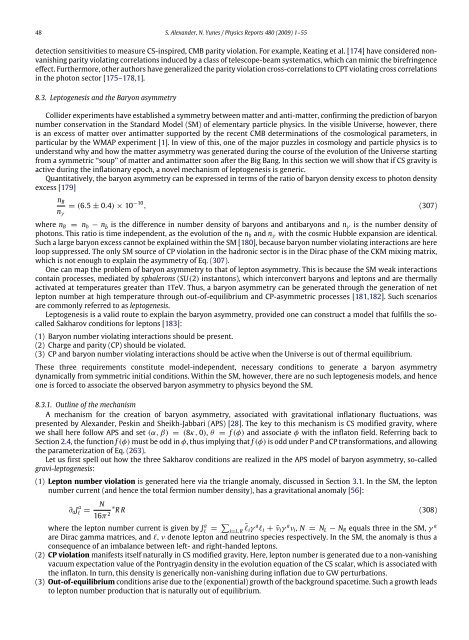Physics Reports ChernâSimons modified general relativity
Physics Reports ChernâSimons modified general relativity
Physics Reports ChernâSimons modified general relativity
Create successful ePaper yourself
Turn your PDF publications into a flip-book with our unique Google optimized e-Paper software.
48 S. Alexander, N. Yunes / <strong>Physics</strong> <strong>Reports</strong> 480 (2009) 1–55detection sensitivities to measure CS-inspired, CMB parity violation. For example, Keating et al. [174] have considered nonvanishingparity violating correlations induced by a class of telescope-beam systematics, which can mimic the birefringenceeffect. Furthermore, other authors have <strong>general</strong>ized the parity violation cross-correlations to CPT violating cross correlationsin the photon sector [175–178,1].8.3. Leptogenesis and the Baryon asymmetryCollider experiments have established a symmetry between matter and anti-matter, confirming the prediction of baryonnumber conservation in the Standard Model (SM) of elementary particle physics. In the visible Universe, however, thereis an excess of matter over antimatter supported by the recent CMB determinations of the cosmological parameters, inparticular by the WMAP experiment [1]. In view of this, one of the major puzzles in cosmology and particle physics is tounderstand why and how the matter asymmetry was generated during the course of the evolution of the Universe startingfrom a symmetric ‘‘soup’’ of matter and antimatter soon after the Big Bang. In this section we will show that if CS gravity isactive during the inflationary epoch, a novel mechanism of leptogenesis is generic.Quantitatively, the baryon asymmetry can be expressed in terms of the ratio of baryon density excess to photon densityexcess [179]n Bn γ= (6.5 ± 0.4) × 10 −10 , (307)where n B = n b − n¯b is the difference in number density of baryons and antibaryons and n γ is the number density ofphotons. This ratio is time independent, as the evolution of the n b and n γ with the cosmic Hubble expansion are identical.Such a large baryon excess cannot be explained within the SM [180], because baryon number violating interactions are hereloop suppressed. The only SM source of CP violation in the hadronic sector is in the Dirac phase of the CKM mixing matrix,which is not enough to explain the asymmetry of Eq. (307).One can map the problem of baryon asymmetry to that of lepton asymmetry. This is because the SM weak interactionscontain processes, mediated by sphalerons (SU(2) instantons), which interconvert baryons and leptons and are thermallyactivated at temperatures greater than 1TeV. Thus, a baryon asymmetry can be generated through the generation of netlepton number at high temperature through out-of-equilibrium and CP-asymmetric processes [181,182]. Such scenariosare commonly referred to as leptogenesis.Leptogenesis is a valid route to explain the baryon asymmetry, provided one can construct a model that fulfills the socalledSakharov conditions for leptons [183]:(1) Baryon number violating interactions should be present.(2) Charge and parity (CP) should be violated.(3) CP and baryon number violating interactions should be active when the Universe is out of thermal equilibrium.These three requirements constitute model-independent, necessary conditions to generate a baryon asymmetrydynamically from symmetric initial conditions. Within the SM, however, there are no such leptogenesis models, and henceone is forced to associate the observed baryon asymmetry to physics beyond the SM.8.3.1. Outline of the mechanismA mechanism for the creation of baryon asymmetry, associated with gravitational inflationary fluctuations, waspresented by Alexander, Peskin and Sheikh-Jabbari (APS) [28]. The key to this mechanism is CS <strong>modified</strong> gravity, wherewe shall here follow APS and set (α, β) = (8κ, 0), θ = f (φ) and associate φ with the inflaton field. Referring back toSection 2.4, the function f (φ) must be odd in φ, thus implying that f (φ) is odd under P and CP transformations, and allowingthe parameterization of Eq. (263).Let us first spell out how the three Sakharov conditions are realized in the APS model of baryon asymmetry, so-calledgravi-leptogenesis:(1) Lepton number violation is generated here via the triangle anomaly, discussed in Section 3.1. In the SM, the leptonnumber current (and hence the total fermion number density), has a gravitational anomaly [56]:∂ a J a l =N16π 2 ∗ R R (308)where the lepton number current is given by Jla = ∑ ¯l i=L,R i γ a l i + ¯ν i γ a ν i , N = N L − N R equals three in the SM, γ aare Dirac gamma matrices, and l, ν denote lepton and neutrino species respectively. In the SM, the anomaly is thus aconsequence of an imbalance between left- and right-handed leptons.(2) CP violation manifests itself naturally in CS <strong>modified</strong> gravity. Here, lepton number is generated due to a non-vanishingvacuum expectation value of the Pontryagin density in the evolution equation of the CS scalar, which is associated withthe inflaton. In turn, this density is generically non-vanishing during inflation due to GW perturbations.(3) Out-of-equilibrium conditions arise due to the (exponential) growth of the background spacetime. Such a growth leadsto lepton number production that is naturally out of equilibrium.



![arXiv:1001.0993v1 [hep-ph] 6 Jan 2010](https://img.yumpu.com/51282177/1/190x245/arxiv10010993v1-hep-ph-6-jan-2010.jpg?quality=85)


![arXiv:1008.3907v2 [astro-ph.CO] 1 Nov 2011](https://img.yumpu.com/48909562/1/190x245/arxiv10083907v2-astro-phco-1-nov-2011.jpg?quality=85)







![arXiv:1002.4928v1 [gr-qc] 26 Feb 2010](https://img.yumpu.com/41209516/1/190x245/arxiv10024928v1-gr-qc-26-feb-2010.jpg?quality=85)
![arXiv:1206.2653v1 [astro-ph.CO] 12 Jun 2012](https://img.yumpu.com/39510078/1/190x245/arxiv12062653v1-astro-phco-12-jun-2012.jpg?quality=85)
